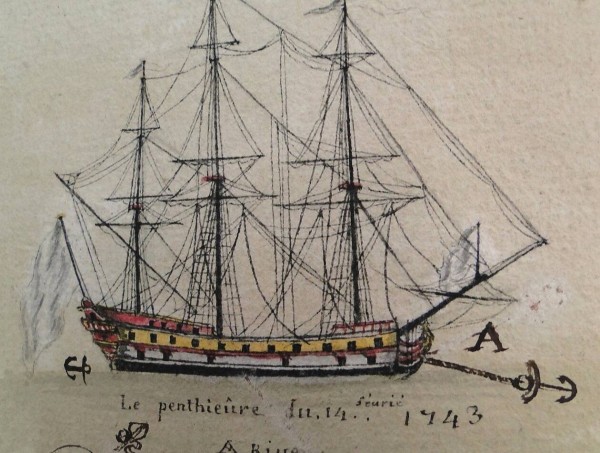
The Prince de Conty was a 600-ton ship, armed with 40 guns and built in L'Orient in 1743.

Porcelain from the French East Indiaman Prince de Conty Shipwreck, 1746. The porcelain is similar to the finds from the Swedish East Indiaman Götheborg, 1745, in particular the cream jug and the tea caddy. The round chrysanthemum between the reserves on the rim of the octagonal basin is not known from the Götheborg cargo. The decoration appears contemporary but with different patterns. Otherwise not much could be told from this small sample.
In December 3, 1746, the Prince de Conty, a frigate belonging to the French East India Company homeward bound from Nanjing, China, with tea, ceramics and roughly 100 gold ingots went down in rocky shoals in the Atlantic near the small coastal island of Belle-Île-en-Mer, France, just 10 miles from shore and only two hours by sea from L'Orient, the Company's official port. She was coming up from Portugal to head for Rouen when Captain Pierre TARTIN made a navigational error which led to tragedy.
Of the 229 men aboard, only forty-five managed to survive. Salvage efforts in 1747 were thwarted by the dangerous waters and quickly abandoned, and the wreck, lying in 10–15 m of water, was soon forgotten.
In 1974, a group of amateur treasure divers from nearby Brittany, acting on local lore, found the wreck. The divers did not report the find to officials as required under French law, that says shipwrecks and their cargo in territorial waters are the property of the state. Instead they kept the site secret. The following year, a gold ingot was discovered during a site survey and the wreck was promptly looted. Legal wrangles tied up the wreck for the next few years.
In 1985, with the disputes resolved, a professional team resumed excavations on the archaeological deposit.
Diving archaeologists observed thousands of fragments of Chinese porcelain dating from the reign of the Qianlong Emperor (1736–95), the remains of tea crates, logs of dyewood, and three little ingots of Chinese gold each weighing between 368 g and 375 g. Some pieces of porcelain that were almost intact were retrieved from nearby underwater caves.
Later that year the excavations were battered by a violent storm. The base ship and equipment were saved at the last minute. The wreck was reburied and its professional excavation was left unfinished.
A